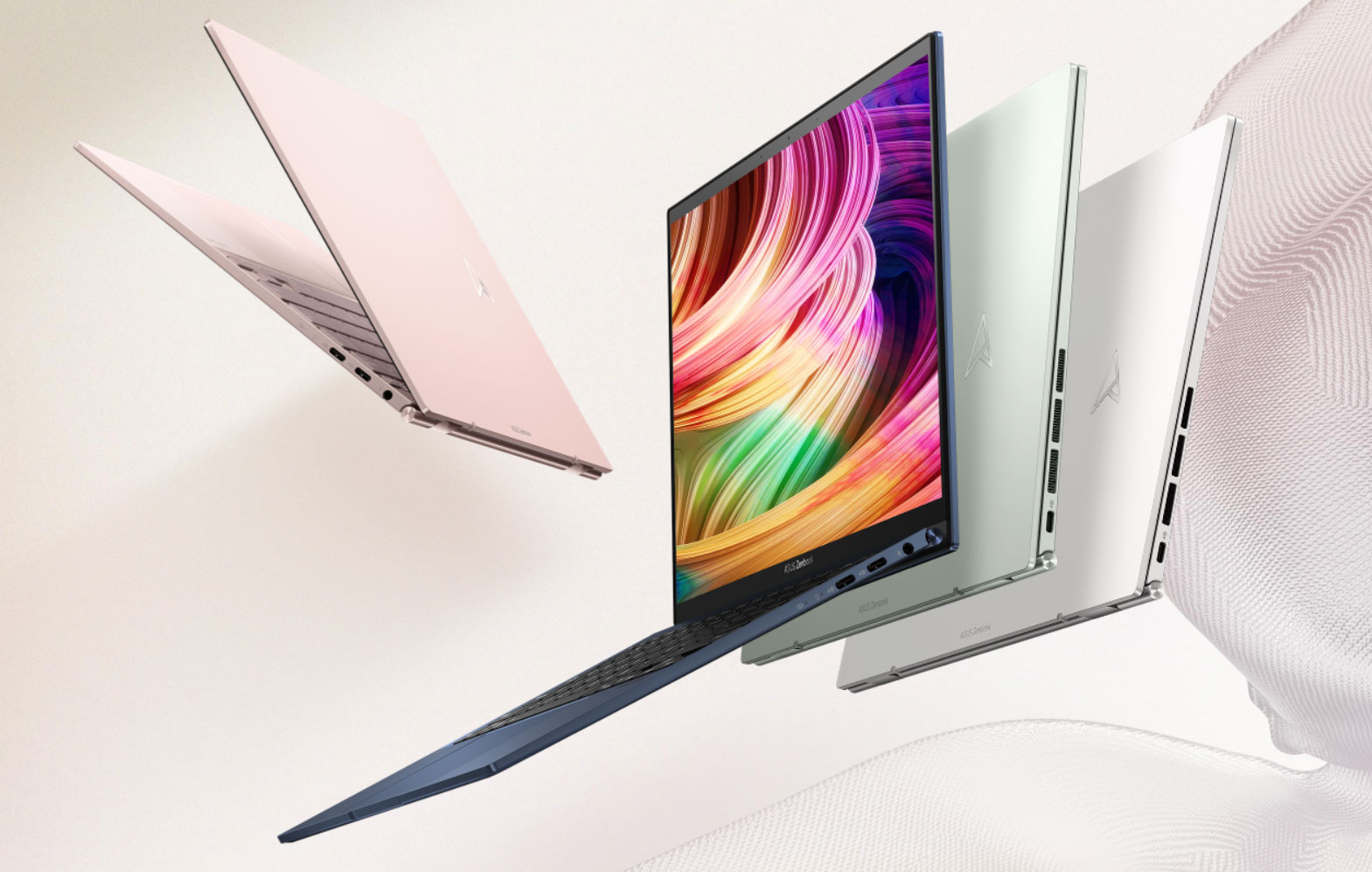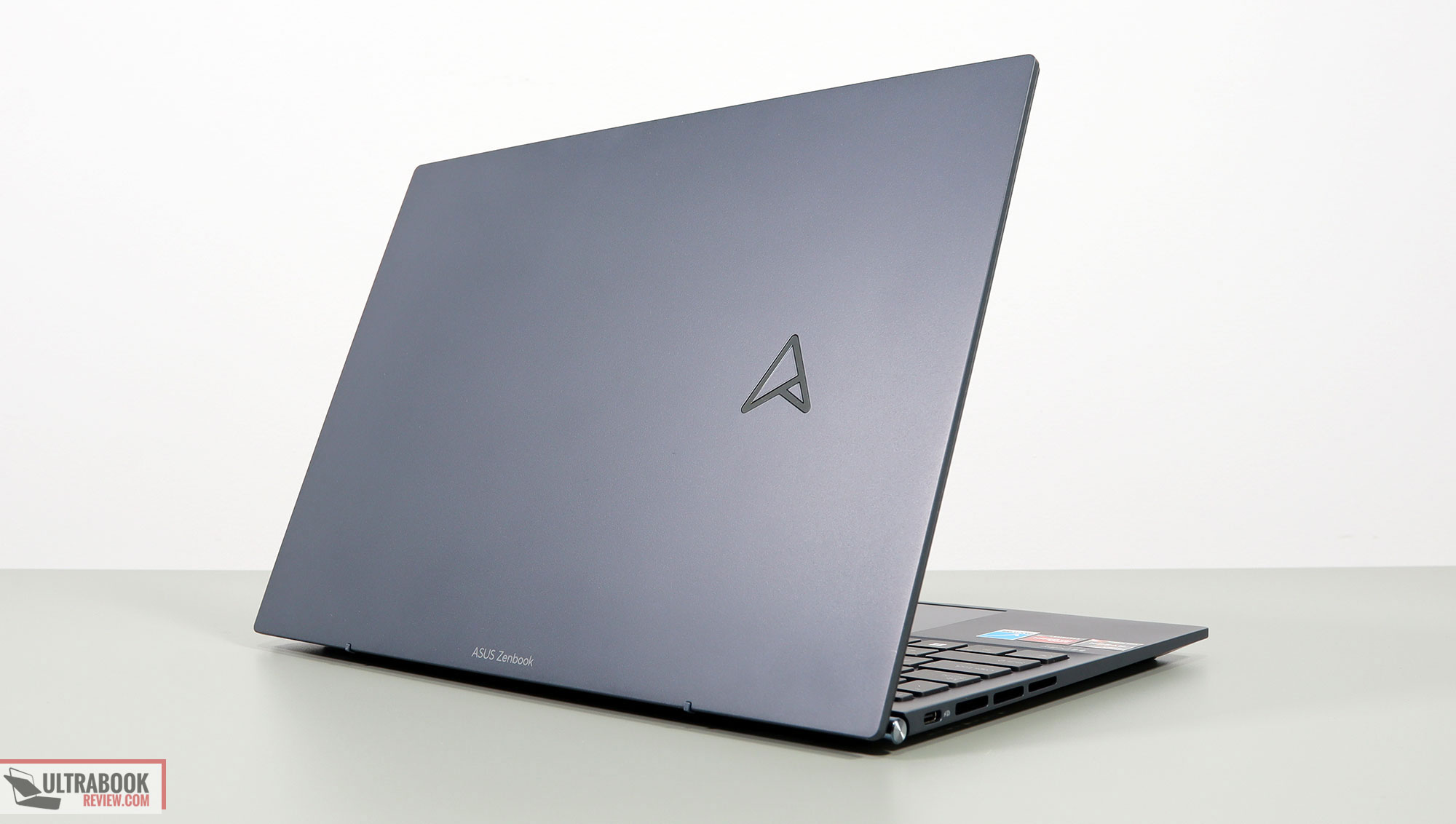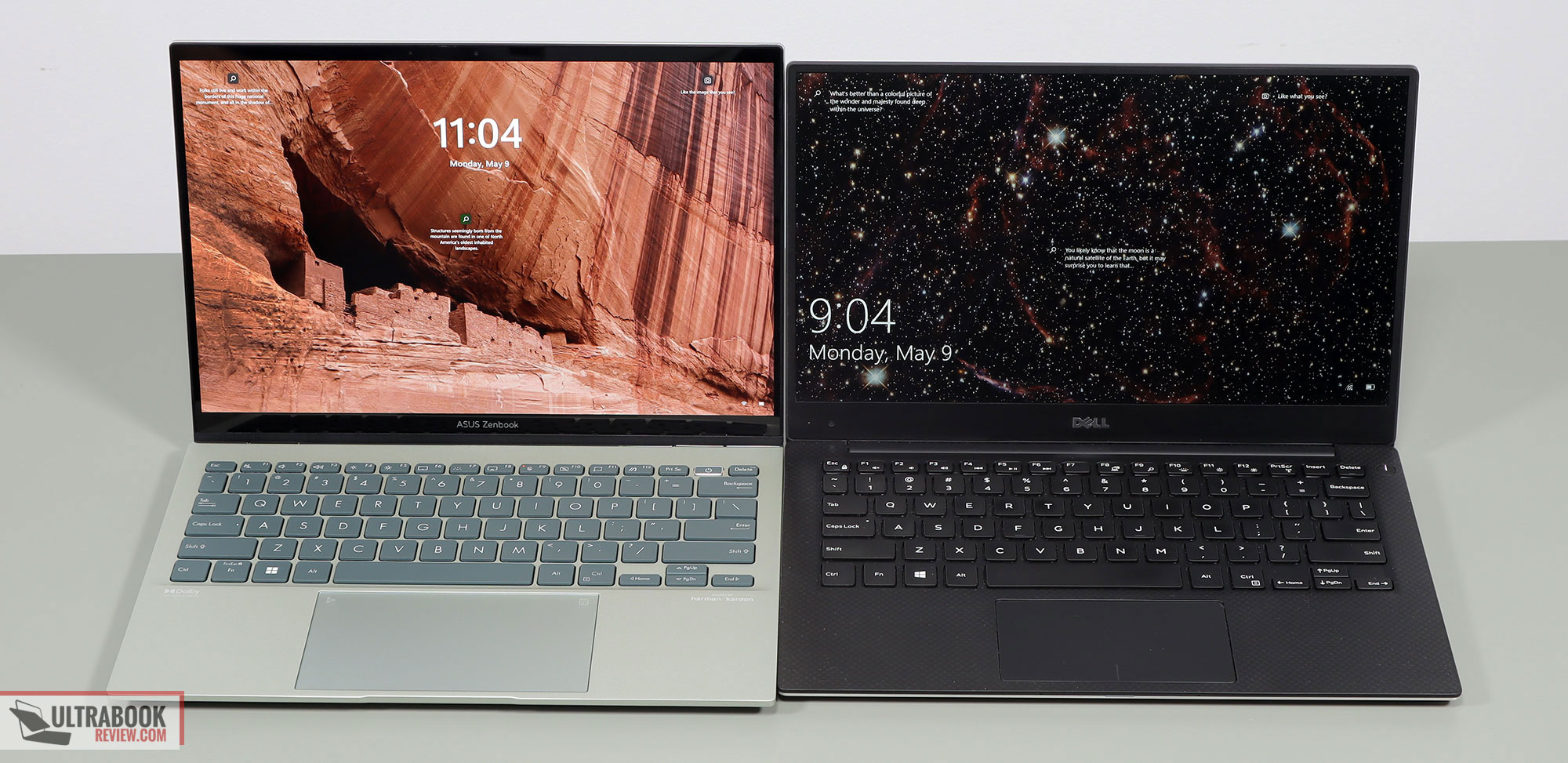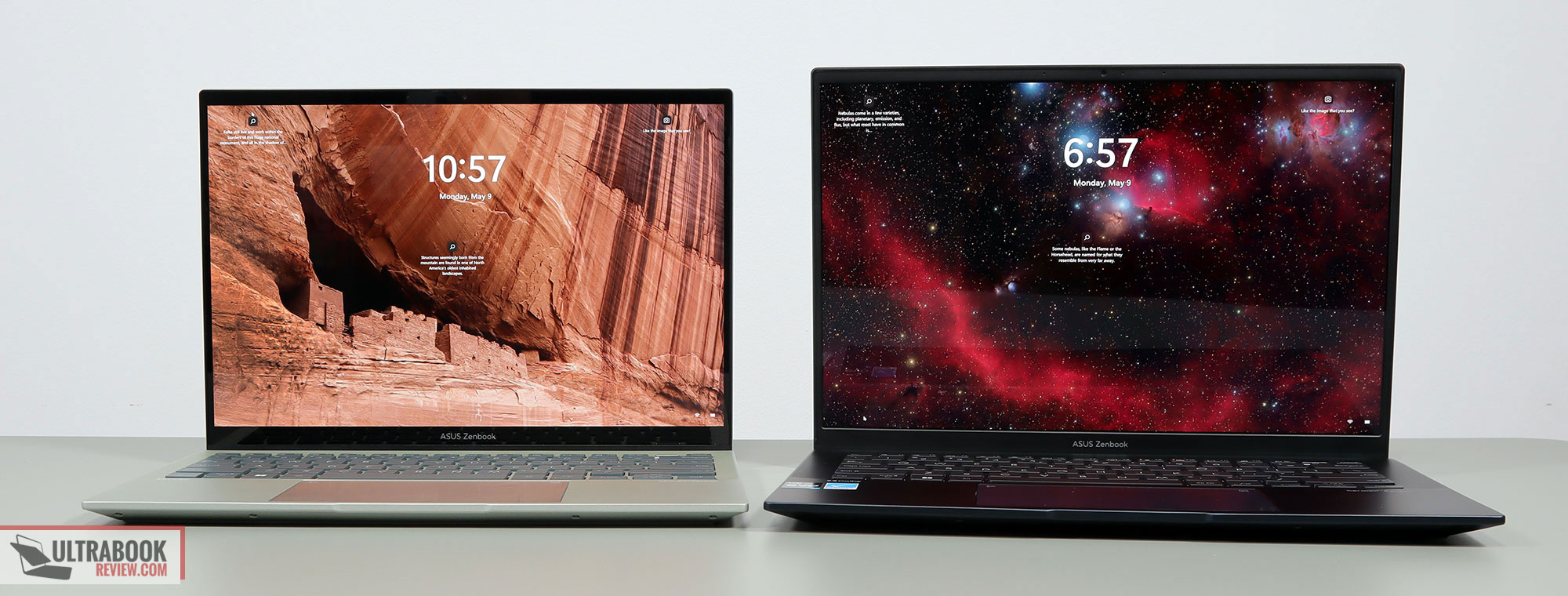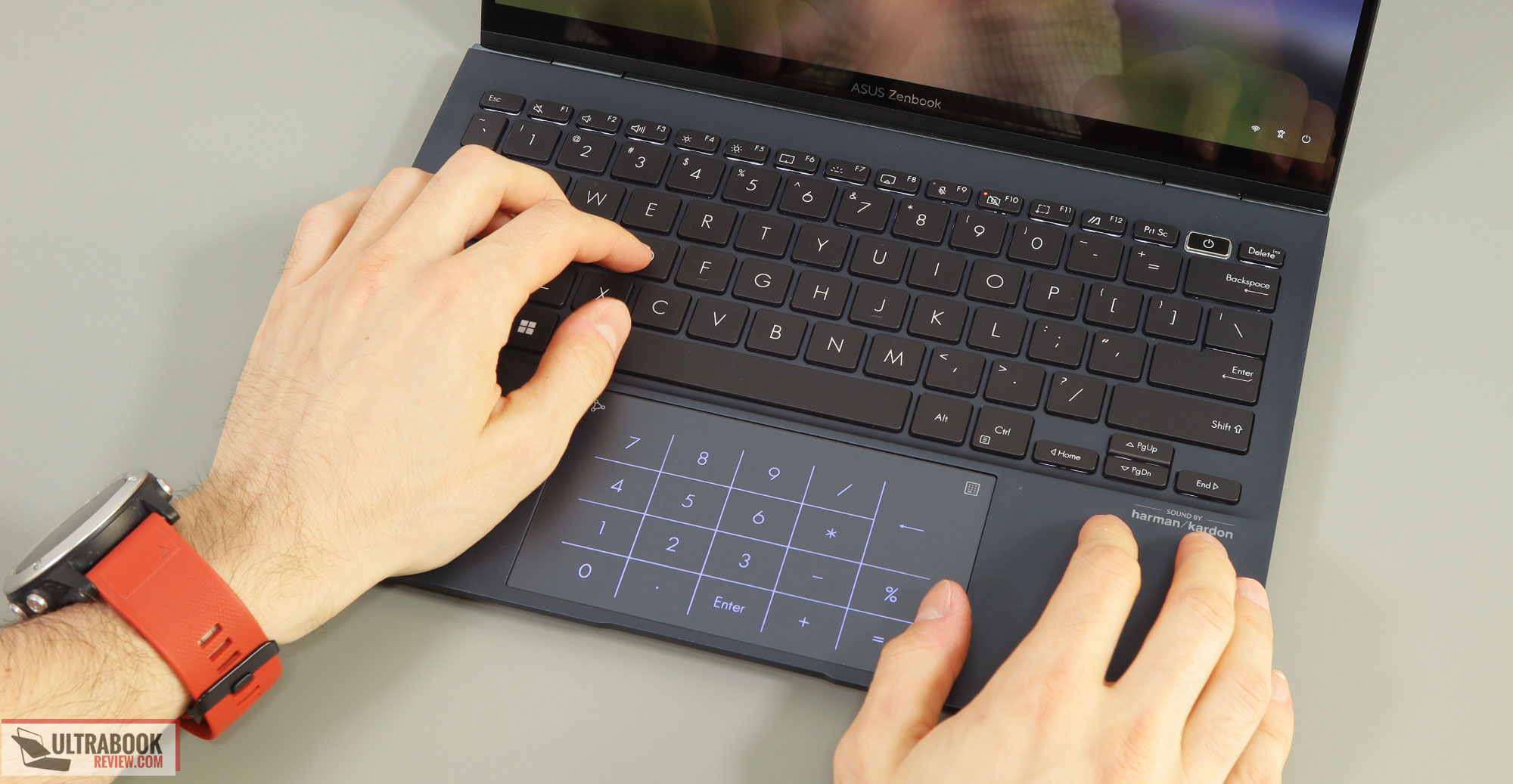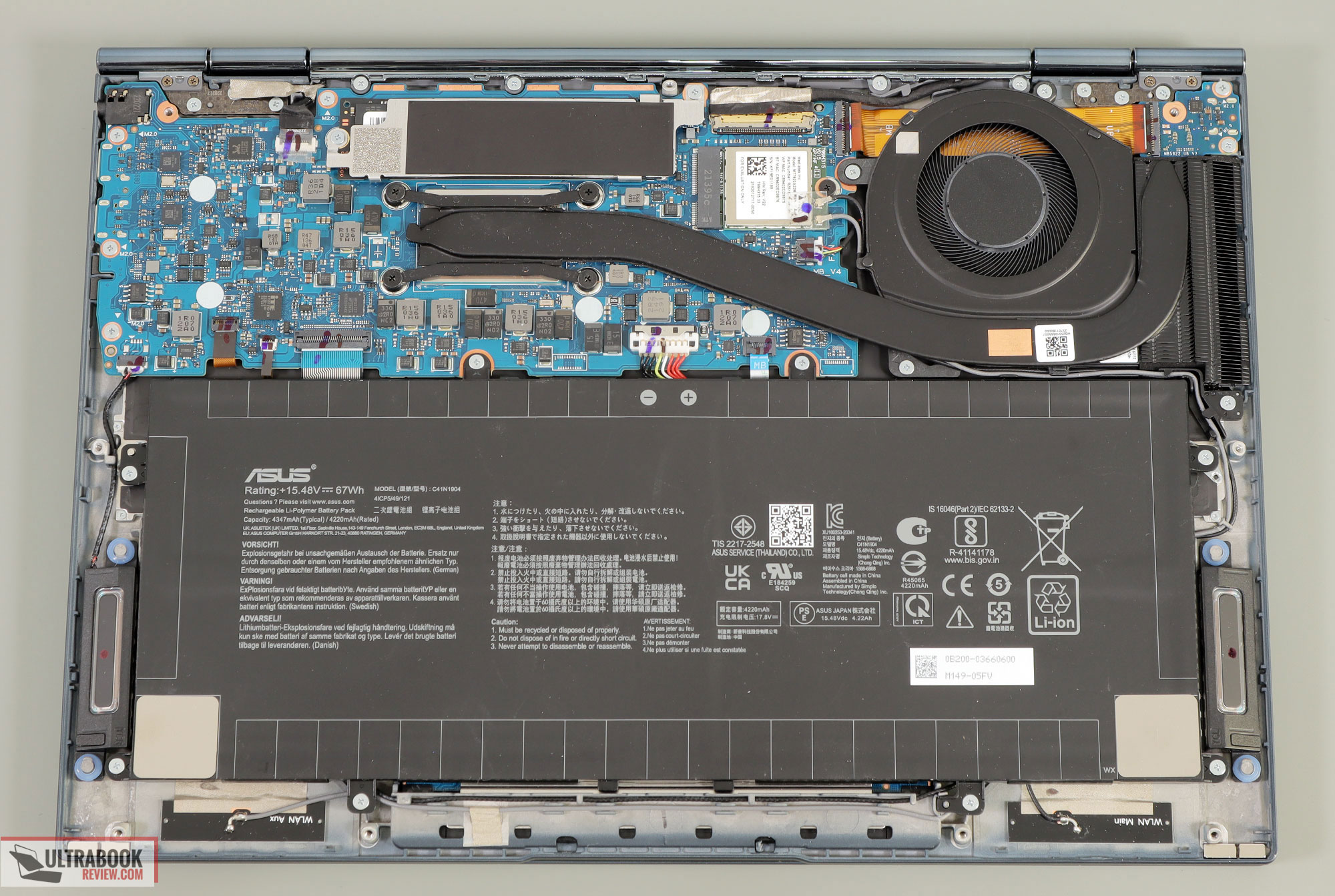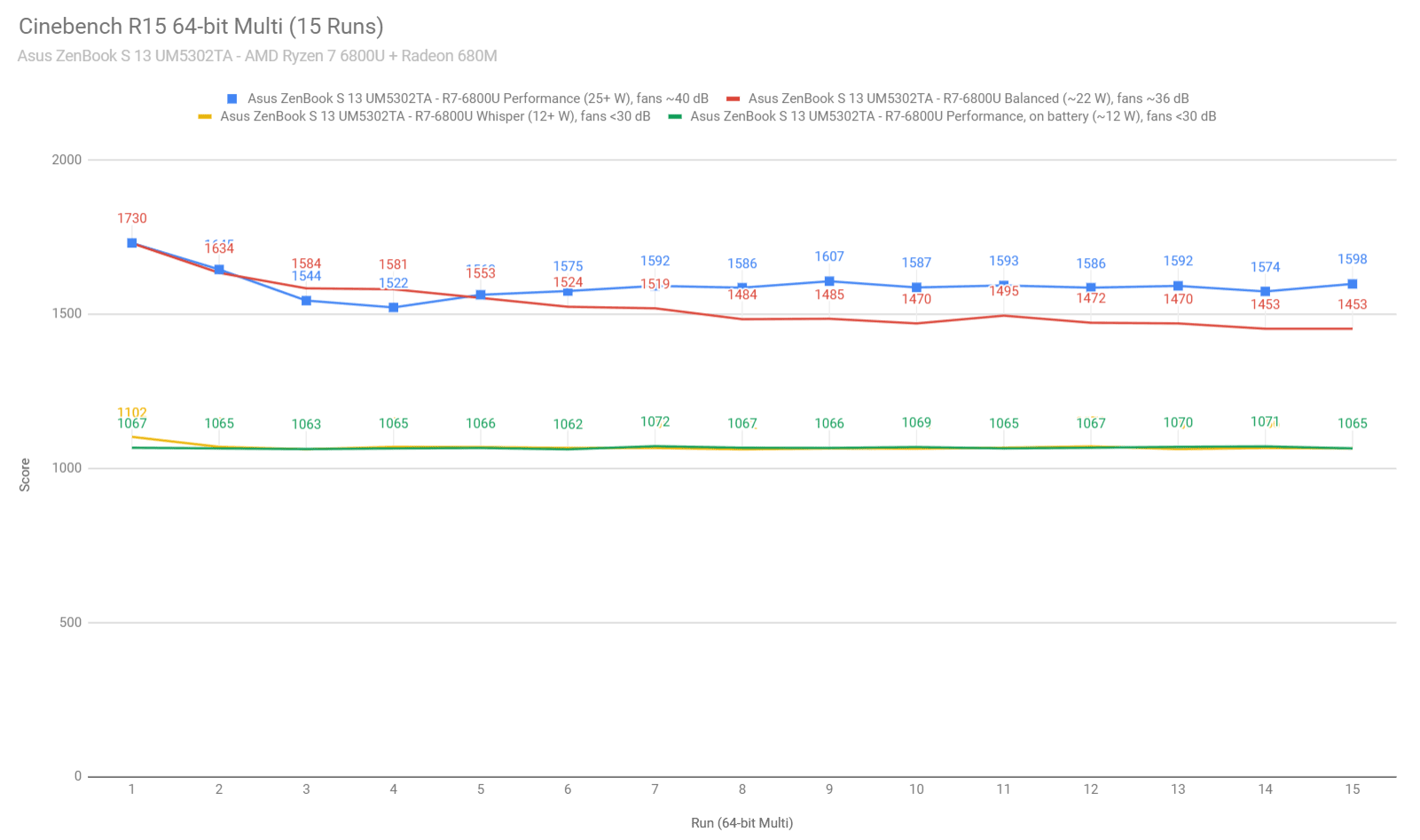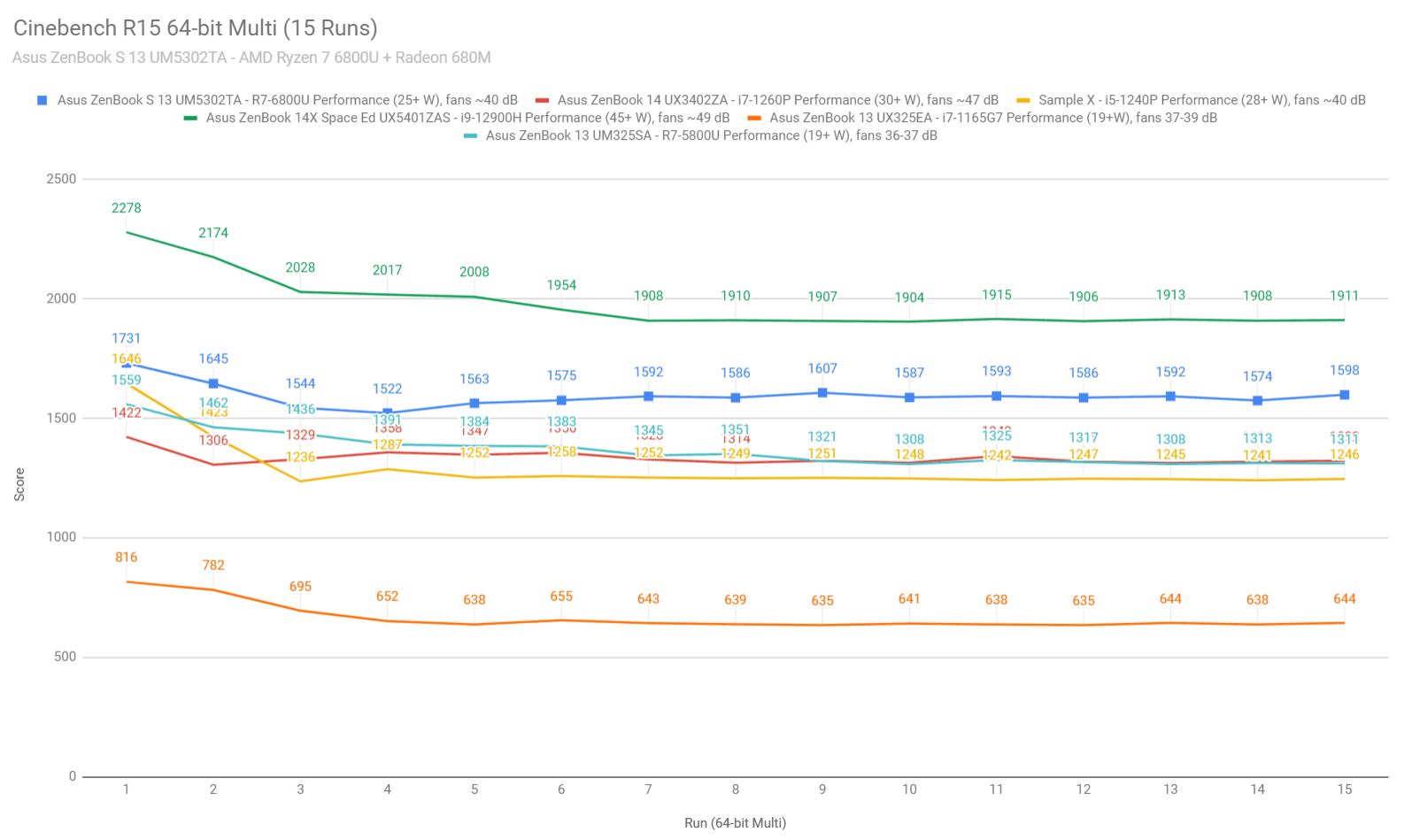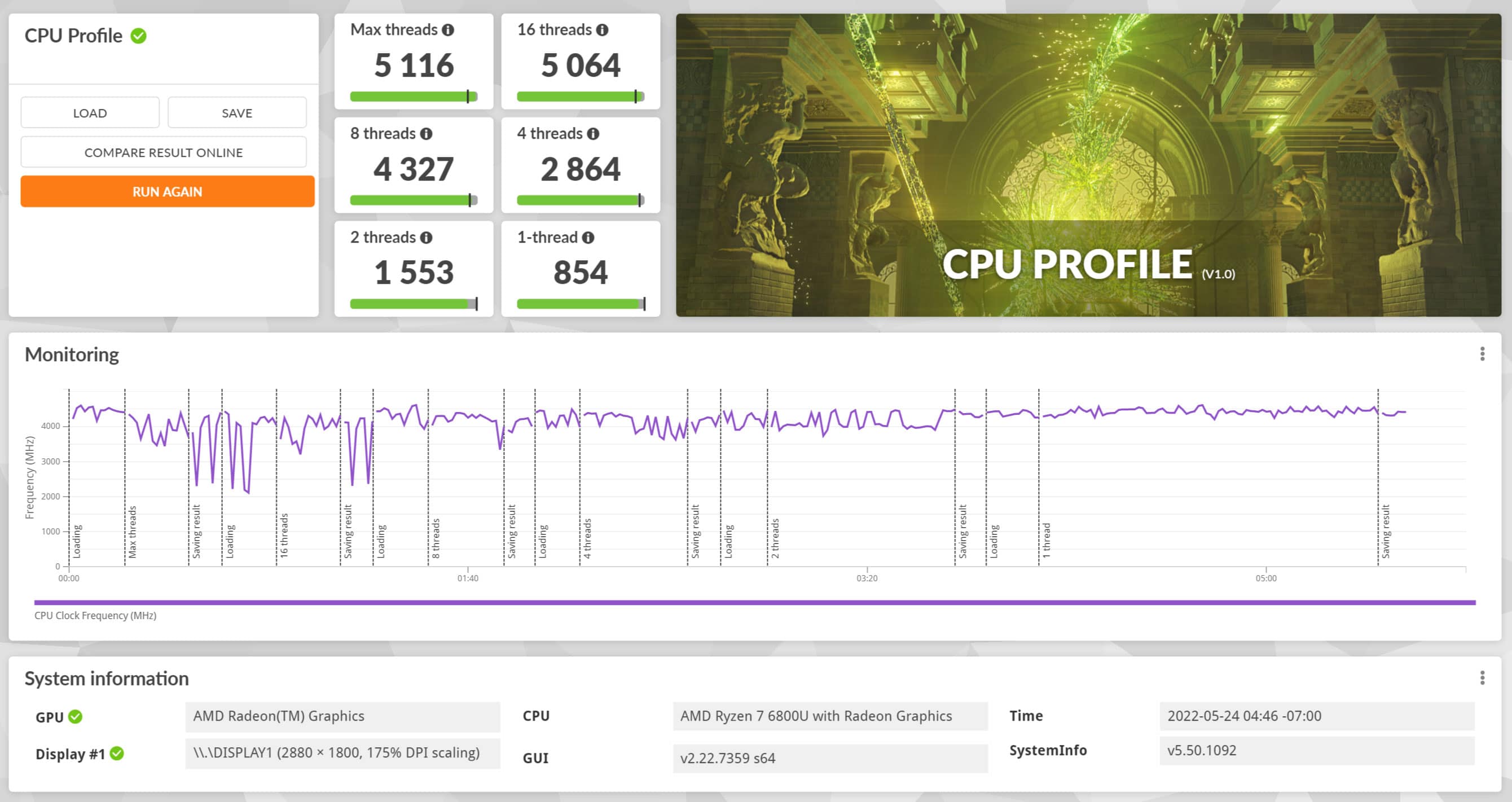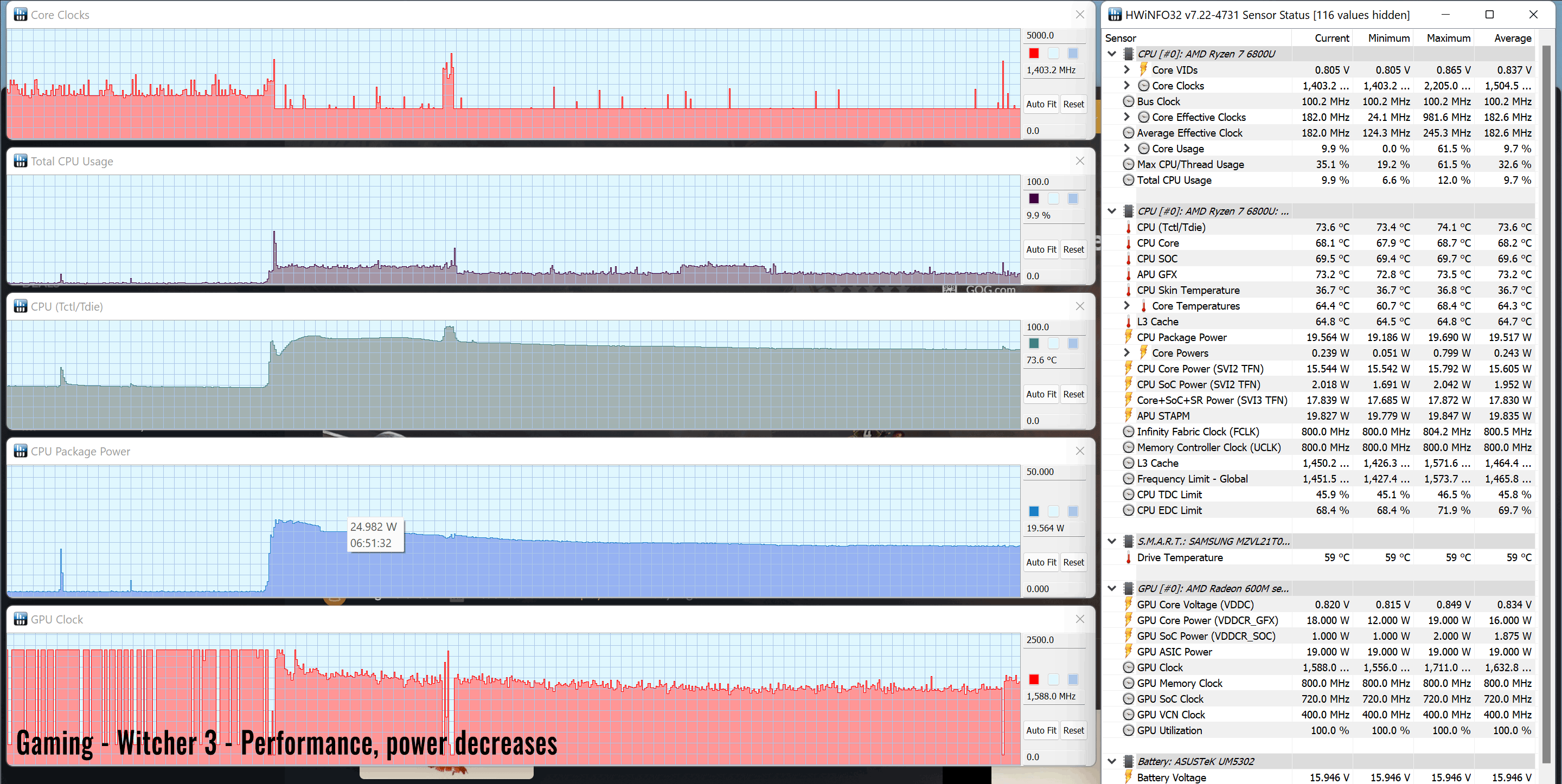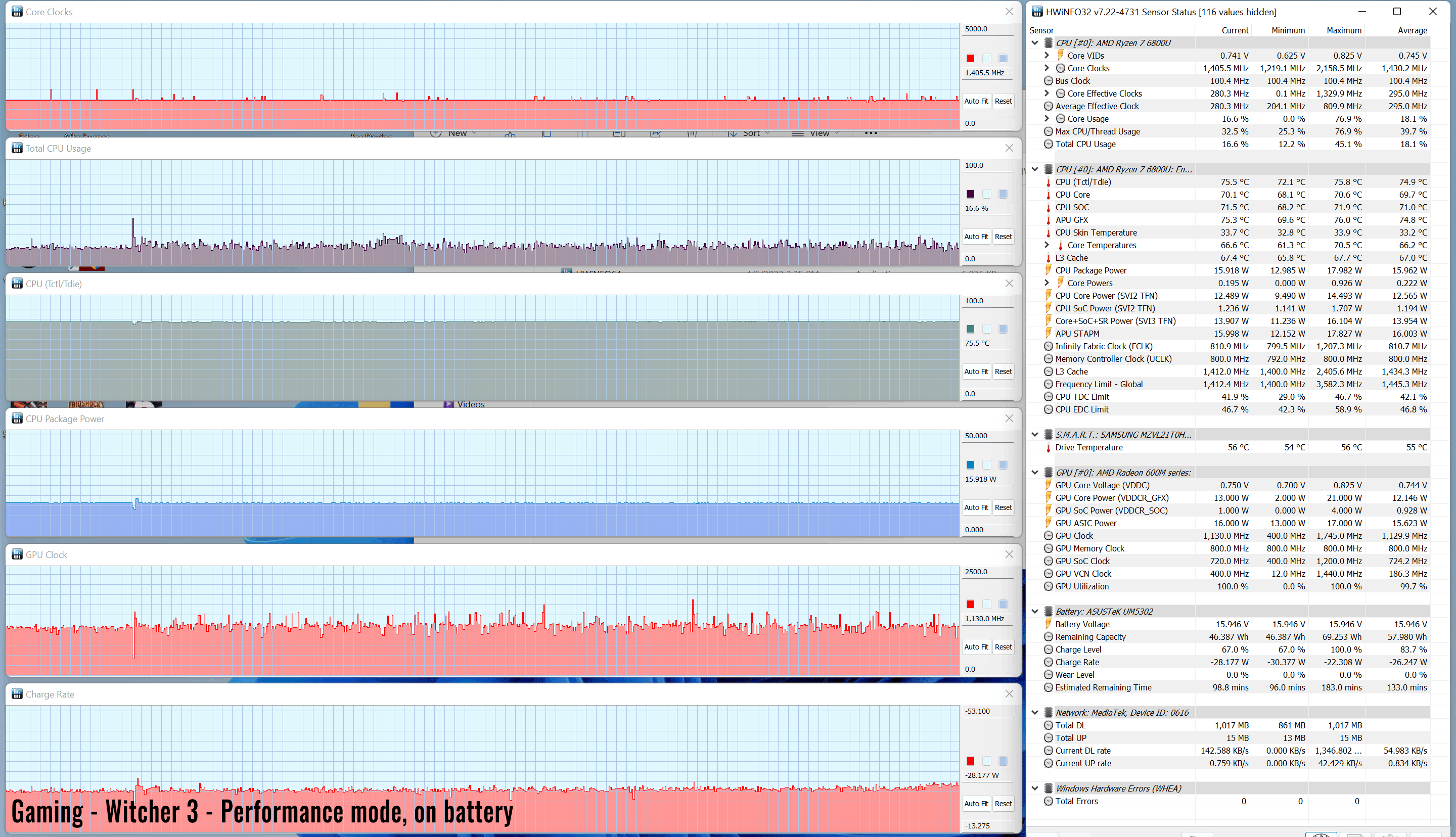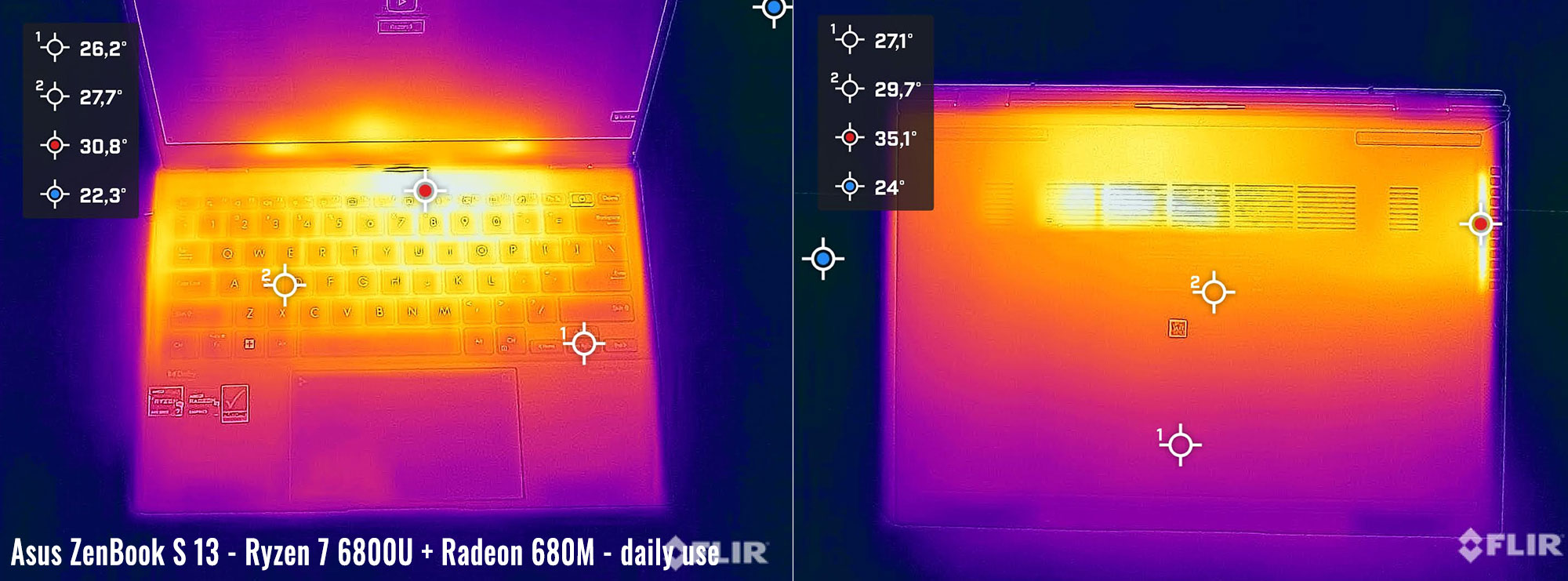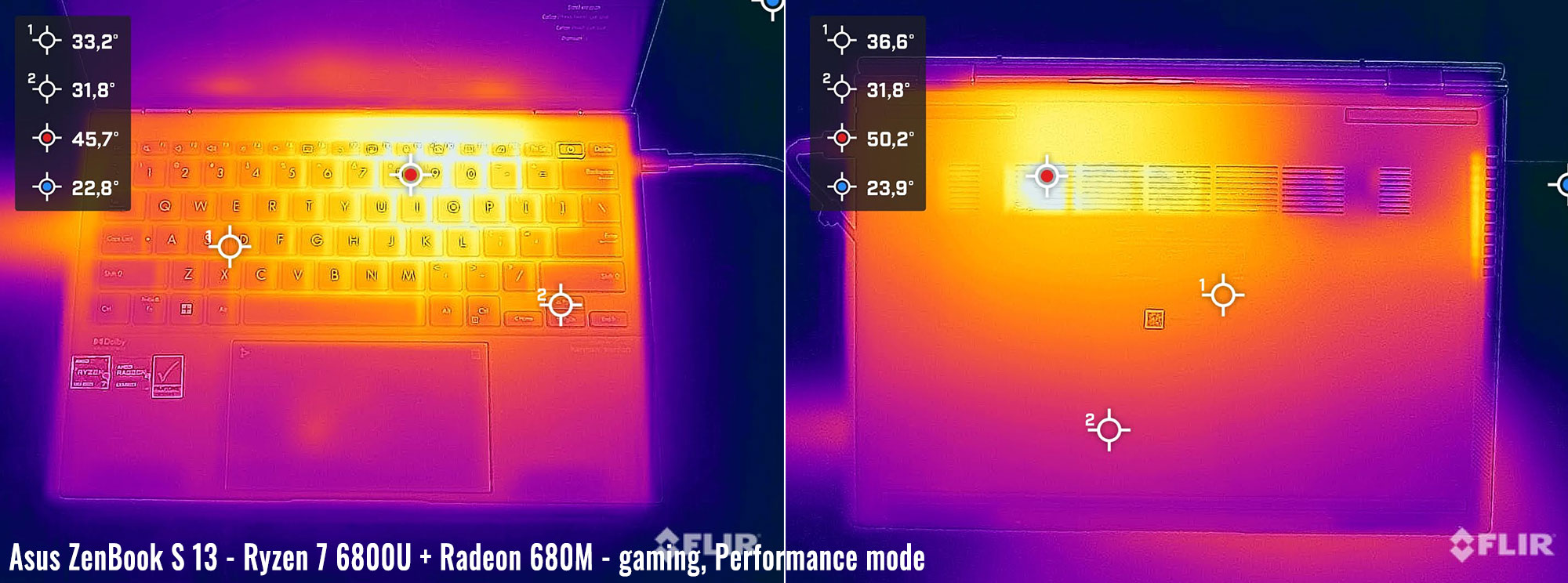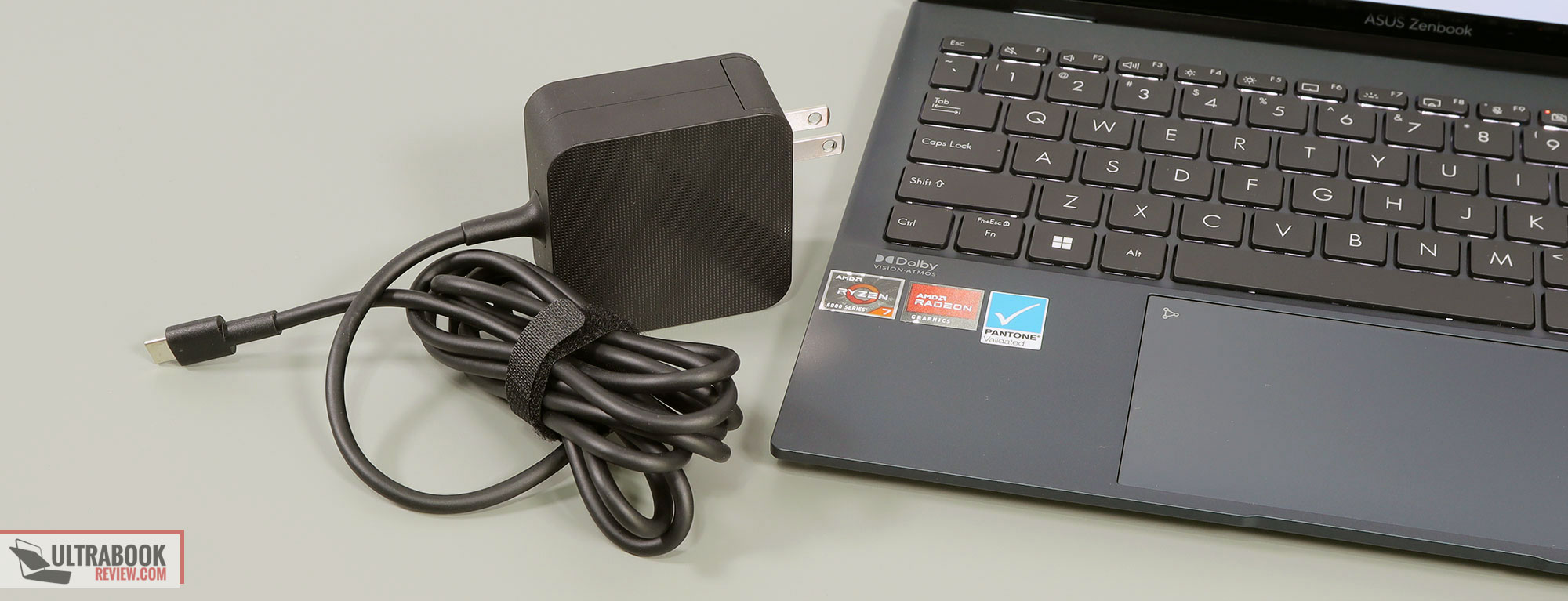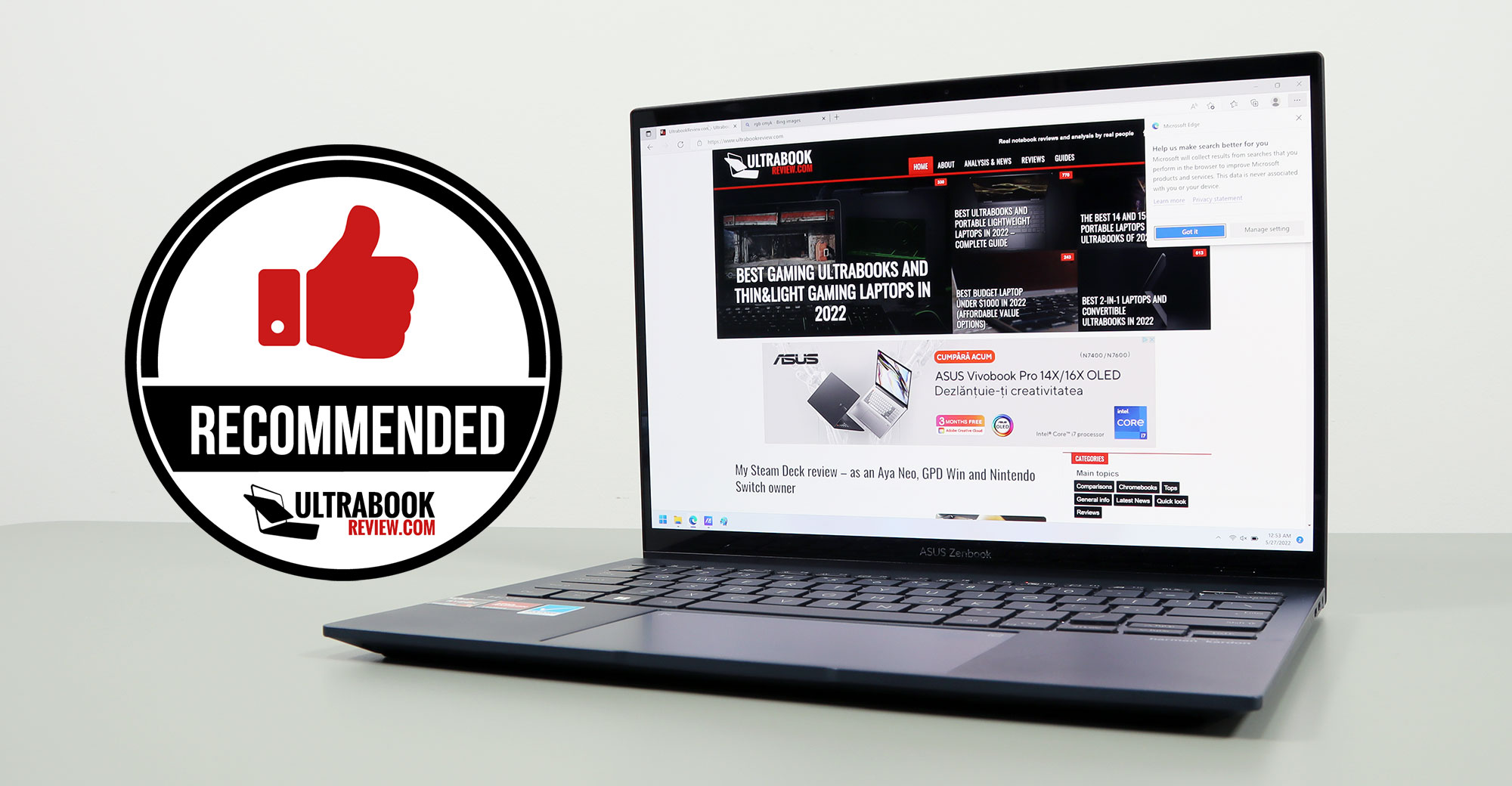
Asus ZenBook S 13 OLED UM5302TA review- (AMD Ryzen 7 6800U, OLED)
This article is my detailed review of the 2022 ZenBook S 13 OLED series, in the UM5302TA configuration built on an AMD Ryzen 7 6800U hardware platform.
In very few words, this laptop is a highly portable 13-inch ultrabook that doesn’t compromise on anything important. It’s well made, offers good inputs and a nice-looking OLED display, and is powerful for its size, able to handle all sorts of demands. On top of these, it’s also a quiet performer and capable of lasting for many hours on each charge, when unplugged from the wall.
Some of these characteristics are a consequence of Asus implementing AMD Ryzen 6000 hardware here, which is the best-balanced platform available in mobile multi-purpose laptops as of mid-2022.
As always though, the devil is in the details, and especially when it comes to the overall performance capabilities of this sort of an ultraportable design. Down below, in this review, we’re going through all these important details that you should be aware of if you’re considering buying a ZenBook S 13 as your next ultrabook.
Specs – Asus Zenbook S 13 UM5302
| Asus Zenbook S 13 UM5302TA | |
| Screen | 13.3 inch, 2.8K 2880 x 1800 px, 60 Hz, OLED, glossy, touch, Samsung SDC4172 panel |
| Processor | AMD Rembrandt 6000, up to Ryzen 7 6800U, 8C/16T |
| Video | AMD Radeon 680M |
| Memory | 16 GB LPDDR5-6400 (soldered) |
| Storage | 1x M.2 PCIe 4.0 x4 SSD (Samsung PM9A1), single M.2 2280 slot |
| Connectivity | Wireless 6E (Mediatek MT7922), Bluetooth 5.2 |
| Ports | 3x USB-C 3.2 with data, video, charging; audio jack |
| Battery | 67 Wh, 65W USB-C charger with quick-charging |
| Size | 297 mm or 11.68” (w) x 210 mm or 8.29 (d) x 14.9 mm or 0.59” (h) |
| Weight | 2.4 lbs (1.08 kg)+ .49 lbs (.22 kg) charger + cables, EU version |
| Extras | white backlit keyboard, glass NumberPad, HD webcam without Hello, finger sensor in the power button, stereo bottom speakers |
Design and construction
I already covered the laptop’s design and build characteristics in the preview article available over here, which you should go over.
Briefly, I’ll reiterate that Asus offers the series in a few color options. We had the Aqua Celadon option for the preview, while this review unit is the Ponder Blue model. The other two are Vestige Beige and Refined White.
They’re all nice looking and get color-matched keyboards, and the potential drawback of this darker-blue variant is the fact that it shows smudges and finger oil easier than the others, both on the arm-rest and lid, but also on the keyboard’s black keycaps.
The other major selling point of this lineup is its overall portability. This weighs shy of 1.1 kilos (2.4 lbs), which makes it a solid travel companion. Sure, there are lighter laptops out there and quite a few sub-1 kilos options, but this is still a well-balanced design that doesn’t compromise on build integrity, inputs, or battery life.
It also feels surprisingly sturdy for its size, and I wasn’t expecting to not experience any flex or squeakiness in the lid and the main chassis, based on my impressions of the previous ZenBook generations. As it is, this 2022 update comes very close in quality to the premium ultrabooks out there, such as the MacBook Air or the Dell XPS 13. All these while being more compact, lighter, and integrating a larger-capacity battery. Well done!
The IO is minimalistic, though, so you will need adapters for various activities.
You’re only getting USB-C ports here, all of them with data, charging, and video. There’s one on the left and two on the right, so you can conveniently charge this on either side. There’s also an audio jack on the right, and the status LEDs are also placed on this edge.
Other than the UBS-C only IO, there’s little to complain about the daily-use experience and the practicality of this design.
Asus are still implementing an Ergolift hinge that lifts the main chassis on small rubber feet placed at the bottom of the screen, allowing for improved airflow into the fans. It works well and the laptop sits stably on the desk even when leaning on those tiny screen feet.
The cooling module has been redesigned. Fresh air still comes inside through the open grills on the bottom of the laptop, but the radiator was moved to the left edge, so the hot air no-longer blows into the screen. To me, this is a major upgrade for this S 13 generation.
Another is the fact that the screen can lean back flat to 180-degrees now, which to me is pretty much a must on an ultraportable design, as it allows to comfortably use it on the lap or on the thighs.
I also appreciate how the screen can be easily picked up and adjusted with a single hand, how the front lips and corners are blunted and comfortable on the wrists, how there’s no longer an always-on light in the power button, how the status LEDs are tucked away on the sides, and how the painted aluminum used for the entire casing provides good grip when grabbing and picking up this laptop.
I’ll also commend Asus for their new design language, with the cleaner lid and the monogram logo. There’s still a shinny Asus ZenBook logo under the display, but I can live with it. You’ll want to peel off all those ugly stickers plastered around the arm-rest, though.
Before we wrap up this section, I must also add that the ZenBook S 13 is not necessarily ultra-compact, as a result of implementing a 16:10 display with noticeable bezels at the top and right. You can tell that from the pictures down below where I have the S 13 next to my old XPS 13.
And here’s how the ZenBook S 13 compares to the mid-sized 2022 ZenBook 14 series, with a similar design and 16:10 panel. It’s smaller, but not by much. You do get full-size ports and an even larger battery with the ZenBook 14 models, but those are also heavier, at 3.1 lbs, and not available with Ryzen 6000 hardware (at least for now).
Overall, while this 2022 ZenBook S 13 OLED UM5302T is not the smallest or the lightest option in the ultrabook space, I’m perfectly fine with the overall balance offered here, especially as it allows for that 16:10 display, for a camera and mics at the top of the screen, and for full-size inputs. The previous ZenBook 13, with its more compact footprint, only offered enough space for a cramped keyboard layout, and I’m happy that Asus steered away from that approach.
Keyboard and trackpad
The keyboard on this ZenBook S13 is identical to what Asus offers with their 14-inch ZenBook in this generation, and it’s overall a good layout and a good typer in this class.
As mentioned in my ZenBook 14 review, the feedback is a bit soft and on the mushier side here, but everything’s fine once you get used to it. Several thousand words in the bag, I was able to type quickly and accurately on this laptop, even more accurately than on the 14-inch model tested a few weeks ago.
The keys are backlit, with white LEDs and three brightness levels to choose from. The system times out after 30 seconds and reactivates with a swipe over the clickpad, and overall the LEDs are bright enough to do what they’re designed to, especially in this pairing with the black keycaps. Uniformity is still a hit and miss, here, with some lights brighter than others. A fair bit of light also shines from underneath the keycaps and is especially visible under the arrows and the top line of function keys.
The clickpad is a large glass surface that works flawlessly with swipes, gestures, taps, etc. It also felt solid on this unit and didn’t rattle with firmer taps; the physical clicks in the lower corners are OK, just a bit clunky.
On top of that, this clickpad doubles as a virtual NumberPad, the kind offered with most ZenBook and VivoBooks these days.
Finally, for biometrics, there’s a finger-sensor with Hello support included in the power button, but no IR-capable camera, although it was available in the past ZenBook models.
Screen
This laptop is available with a 13.3-inch 16:10 glossy OLED 2.8K panel, in either a touch or a non-touch variant.
This is a recent-gen Samsung-made OLED panel, similar to what Asus offers with their 14-inch ultraportables. The only notable difference is the refresh rate, capped at 60 Hz here, while the 14-inchers are available in 90 and even 120 Hz options. It’s not a deal-breaker by any means, but perhaps something you might notice with fast-paced action and games.
Other than that, this is still a 10-bit panel with HDR 500 support, 100% DCI-P3 color coverage, and excellent blacks/contrast, but sustained SDR brightness of only around 350-nits for this touch variant.
Asus advertises this panel as up to 550-nits peak brightness for the touch model and 600-nits for the non-touch option, which I find rather misleading because it refers to peak HDR brightness in HDR content. In reality, this display is only about 350-nits with normal content, while the non-touch option goes up to 400-nits, which means it is barely adequate for proper use in bright environments and that it will struggle outdoors. Paired with the glary glass finishing, this laptop is mostly suited for indoor use.
I’ll also mention that I’m still noticing that slight graininess effect on white backgrounds on the touch variant of this display, as on all the OLED touch displays offered these days (it’s not just an Asus thing, we also noticed it on the Yoga 9i). However, because of the higher density of this 13-inch 2.8K panel, this effect is not as easily observable as on the 14+ inch OLED models, to the point that it barely bothered me with actual use here. On top of that, the image is perfectly clear on the non-touch models, as the graininess is a side-effect of the touch /digitizer layers.
Here’s what we got in our tests, with an X-Rite i1 Display Pro sensor (with HDR switched off):
- Panel HardwareID: Samsung SDC4172 (ATNA33AA03-0);
- Coverage: 100% sRGB, 96.8% Adobe RGB, 99.7% DCI-P3;
- Type: 10-bit with HDR500, 60 Hz;
- Measured gamma: 2.17;
- Max brightness in the middle of the screen: 352.27 cd/m2 on power;
- Min brightness in the middle of the screen: 2.98 cd/m2 on power;
- Contrast at max brightness: 1:1;
- White point: 6600 K;
- Black on max brightness: 0 cd/m2;
- PWM: to be discussed.
This panel came well calibrated out of the box and turned out to be uniform in luminosity and color. Plus, since this is OLED, you don’t have to concern yourself with any light bleeding on black backgrounds.
Panel quality aside, the other advantages of OLED panels should also be considered in your decision, such as the lower blue-light emission and the way colors are perceived more vividly at mid-brightness levels, but also their potential downsides, such as black-crush, gray-bending, flickering, and even burn-in to some extent.
I don’t have the right tool to test for PWM, but most of these latest-gen Samsung OLEDs do not use PWM and are flicker-free. Look for other reviews for confirmation, though. Furthermore, I wouldn’t worry about burn-in with this newer generation of Samsung OLED panels, either, just make sure you’re hot disabling the burn-in protection tech in the MyAsus app, and not use this at max-brightness for hours, especially while displaying static interfaces.
Nonetheless, if OLED is not your thing, and not necessarily due to quality concerns, but especially because all OLEDs are glossy and you might preffer matte finishes on ultrabooks (which I do myself), then tough luck. This series is not available with any matte IPS screen option this year.
You might still find matte IPS variants with the 14-inch ZenBooks, but even those are a rare occurrence these days, as Asus are aggressively pushing their OLED options; plus, these are only available with Intel or AMD Ryzen 5000 hardware. You will get an IPS screen with the Ryzen 6000 U powered Lenovo Yoga 7 at some point this year, or with the Ryzen 6000 HS ROG Flow X13, but those are touch as well, so I’m not aware of any matte-screen alternative with similar specs at this point.
Hardware and performance
Our test model is a top-specced configuration of the 2022 Asus ZenBook S 13, code name UM5302TA, with an AMD Ryzen 7 6800U processor and Radeon 680M graphics, 16 GB of LPDDR5-6400 memory, and a fast 1 TB gen4 SSD.
Disclaimer: This review unit was provided by AMD for this article. We tested it with the software available as of late-May 2022 (BIOS 306, MyAsus 3.1.4 app). Some aspects might still change with future software updates.
Spec-wise, the 2022 ZenBook S 13 is built on the latest AMD Ryzen U hardware available to date for the ultraportable segment.
The Ryzen 7 6800U is an AMD Rembrandt 6000 processor, with 8 Cores and 16 Threads. This is a revision of the Ryzen 5000 platform previously implemented in the 2021 ZenBook 13 reviewed here (5800U model) and here (5600U model).
However, the ZenBook S 13 is a 13-inch ultraportable design, thus Asus could only implement limited sustained power settings here. As a result, and paired with the quiet fan profiles and basic thermal design, the Ryzen 7 6800U runs at between 15 to 25 W of power in this chassis, and I’ll explain how this impacts the platform’s performance further down in this review.
For the GPU, you’re getting the integrated RDNA2 AMD Radeon 680M iGPU part of the Ryzen 7 6800U platform, which proved an excellent performer in our previous analysis. However, this iGPU requires about 45W of sustained CPU+GPU power to run at its peak potential, which is not possible in this power-restrained design.
The memory is soldered on the motherboard and Asus offers 16 or 8 GB configurations, all with LPDDR5-6400 memory. Our unit is the 16 GB version.
As for the storage, the laptop offers an M.2 2280 gen4 slot, and our unit shipped with a Samsung PM9A1 drive, one of the faster gen4 options available these days.
You can remove the laptop’s back panel in order to access the SSD slot, the WiFi module, and the other components. This panel is held in place by a couple of Torx screws, with two of them visible under the rear-rubber feet. The design of these feet allows to easily peel off their exterior corners and get to the screws, making the disassembly process more facile than on other ZenBooks.
As far as the software goes, this ZenBook gets the standard MyAsus app which allows control over the power profiles, battery and screen settings, updates, etc.
There are three performance/thermal profiles to choose from:
- Performance – allows the hardware to run at ~15-25W in sustained loads, with fans ramping up to 40 dB;
- Balanced/Standard – allows the hardware to run at 15-25W in sustained loads, with fans ramping up to ~36 dB;
- Whisper – limits the CPU at 12W to favor fan noise of sub 30 dB.
Whisper mode is OK for light use, but I’d recommend keeping the laptop on Standard in most cases, to prevent any sluggishness.
The Performance mode offers faster processing capabilities in sustained loads, while not being significantly louder. In fact, the Performance mode on this ZenBook S 13 is a lot quieter than the Performance mode on the ZenBook 14 UX3402 reviewed recently. That could allow Asus to ramp up the fan with a future BIOS update, and potentially improve the capabilities of this Performance mode.
We’ll get to that in a bit, but first, here’s what to expect in terms of speeds and temperatures with daily use, with the laptop running quietly, but almost never completely silent.
Performance and benchmarks
On to more demanding loads, we start by testing the CPU’s performance in the Cinebench R15 loop test.
On the Performance mode, the Ryzen 7 6800U processor peaks at 30W for a little while and then quickly drops and stabilizes around a 25 W power limit, with temperatures in the mid-90s Celsius, and fan-noise levels of ~40 dB. These result in sustained Cinebench scores of around 1600 points.
Bumping the back of the laptop off the desk in order to improve cooling is allowing the CPU to run a few degrees cooler, at 91-92 C, while still at the same 25W power limit (further illustrated in the Cinebench R23 logs down below)
On Balanced, the system limits the fans to around 36-37 dB noise levels. The CPU ends up stabilizing at 20-22W, with temperatures in the high 80s C. The performance takes a ~10% hit, with the scores stabilizing around 1450 points.
You can also opt for the Whisper mode, with limits the CPU at 12W with now barely audible fans, and temperatures in the high-60s. The laptop performs at about 60% of its abilities on this profile, returning scores of around 1050 points. That’s excellent for such a low-powered profile.
Finally, the performance on battery on the Performance mode in this test is similar to the Whisper mode plugged in, with the CPU stabilizing at around 12W of power.
All these are illustrated in the graph below.
To put these in perspective, here’s how this AMD Ryzen 7 6800 implementation fares against other hardware platforms available in competing ultraportables.
It outscores the Intel Core i7-1260P or i5-1240P running at higher power (30W, 28W respectively) by about 20%, and outscores the Ryzen 7 5800U in the ZenBook 13 by about 20% as well, but that’s mostly a result of this generation running at 25W, while the previous only ran at sub-20W. At similar power, the generational gains between the two in this CPU-taxing load are at around 5-7%.
I also expect this Ryzen 7 6800U to be a match for ultraportables built on the top-tier Core i7-1280P platform at around 25-30W, but higher power Intel implementations are going to outmatch it. And so will higher power implementations of the Ryzen 6000 HS hardware available in devices such as the Flow X13 or the Zephyrus G14. We’ll further discuss the 6800U in a separate article.
We then went ahead and further verified our findings with the more taxing Cinebench R23 loop test and in Blender, confirming our above findings.
We then ran the 3DMark CPU profile test.
Finally, we ran our combined CPU+GPU stress tests on this notebook, on the Turbo profile. 3DMark stress runs the same test for 20 times in a loop and looks for performance variation and degradation over time, and this unit failed it, which means that the performance diminishes with longer-duration sustained loads, as the heat builds up and the system goes down in power in order to cope with the temperatures.
We’ll go over this in-depth in the gaming section down below.
But first, here are some benchmark results. We ran the entire suite of tests and benchmarks on the Performance profile on this AMD Ryzen 7 6800U configuration, with the screen set on FHD resolution, for consistency with other laptops tested in the past.
- 3DMark 13 – Fire Strike: 5765 (Graphics – 6286, Physics – 18940, Combined – 2164);
- 3DMark 13 – Night Raid: 22234 (Graphics – 27737, CPU – 10468);
- 3DMark 13 – Time Spy: 2367 (Graphics – 2119, CPU – 7064);
- Uniengine Superposition – 1080p Extreme: 1267;
- Uniengine Superposition – 1080p Medium: 4199;
- Handbrake 1.3.3 (4K to 1080p encode): 36.60 average fps;
- PassMark 10: 5787 (CPU – 20285, 3D – 4692, Memory – 2287, Disk – 33150);
- PCMark 10: 5913 (Essentials – 9442, Productivity – 8395, Digital Content Creation – 7078);
- GeekBench 5.4.3 64-bit: Single-Core: 1497, Multi-core: 7575;
- CineBench R15 (best run): CPU 1702 cb, CPU Single Core 229 cb;
- CineBench R20 (best run): CPU 3905 cb, CPU Single Core 561 cb;
- CineBench R23: CPU 9434 cb (best run), CPU 9350 (10 min loop test), CPU Single Core 1439 CB (best run);
- x265 HD Benchmark 64-bit: 37.72 s.
And here are some workstation benchmarks, on the same Performance profile:
- Blender 3.01 – BMW Car scene- CPU Compute: 4m 13s ;
- Blender 3.01 – Classroom scene – CPU Compute: 9m 28s;
- PugetBench – DaVinci Resolve: 350;
- PugetBench – Adobe After Effects: 489;
- PugetBench – Adobe Photoshop: 703;
- PugetBench – Adobe Premiere: 266;
- SPECviewperf 2020 – 3DSMax: 29.24;
- SPECviewperf 2020 – Catia: 18.26;
- SPECviewperf 2020 – Creo: 32.91;
- SPECviewperf 2020 – Energy: 1.04;
- SPECviewperf 2020 – Maya: 79.51;
- SPECviewperf 2020 – Medical: 14.39;
- SPECviewperf 2020 – SNX: 37.58;
- SPECviewperf 2020 – SW: 38.67.
- V-Ray Benchmark: CPU – 7074 vsamples, GPU CUDA – 168 vpaths;
These are some solid results for a 13-inch ultraportable design, but they need to be dissected for a proper understanding of the particularities of this Ryzen 7 6800U implementation.
For starters, we need to analyze the impact of the sub-25W power limit applied on the AMD hardware with this design, and for that, we compare these scores with our review of the iGPU-only variant of the ROG Flow X13 that allows a 45+W Ryzen 9 6900HS implementation.
We’re looking at about 15% superior CPU multi-core performance and 20% gains in GPU performance for the Flow X13, which is also close to what we could expect from a 6800U at 45W of power, acknowledging of course for the small CPU frequency differences between the 6800U and the 6900HS. In other words, even at sub-25W, the Ryzen 7 6800U scores within 80-85% of its maximum potential capabilities, which showcases this platform’s excellent power scaling.
Now, compared to a Core i7-1260P implementation running at a slightly higher 30W of power in the ZenBook 14, this AMD 6800U model wins the graphics tests by a significant margin of around 20-30%. However, CPU scores are neck in neck, with the 1260P winning in single-core tests as expected given the higher frequency and IPC advantage, but also in most of the short-duration CPU multi-threaded tests. That’s because the i7-1260P runs at up to 43W of power for short bursts in the ZenBook 14, while the Ryzen 7 6800U only runs at up to 30W in this S 13 model.
The sustained performance is illustrated by the long-duration benchmarks such as Blender Classroom, where the Ryzen 7 6800U @25W ends up outmatching the Core i7-1260P @30W.
Finally, I’ll also mention that this 2022 ZenBook S 13 running on the Ryzen 7 6800U platform ends up outmatching last year’s ZenBook 13s running on the Ryzen 7 5800U platform by 10-20% in CPU multi-threaded loads, and by 50-80% in the GPU loads. That’s no surprise, given the 5800U and 6800U are similar on the CPU side, but the major update for the 2022 Ryzen 6000 Rembrandt generation is the transition to the much more capable Radeon 680M iGPU.
At this point in our reviews, I’m normally adding benchmark results for the quieter mid-tier Balanced profile, but I haven’t run the tests here yet, because the Performance mode already runs at quiet fan levels in this ZenBook, at up to 40 dB. Hence, I see no reason why you would keep this laptop on anything but the Performance mode when running demanding loads.
Update: Here are the benchmarks results on the Balanced mode:
- 3DMark 13 – Fire Strike: 5101 (Graphics – 5568, Physics – 16411, Combined – 1917);
- 3DMark 13 – Time Spy: 2050 (Graphics – 1837, CPU – 5989);
- Uniengine Superposition – 1080p Medium: 3931;
- GeekBench 5.4.3 64-bit: Single-Core: 1489, Multi-core: 7429;
- CineBench R20 (best run): CPU 3856 cb, CPU Single Core 550 cb;
- CineBench R23: CPU 9468 cb (best run), CPU 8754 (10 min loop test), CPU Single Core 1419 CB (best run);
- x265 HD Benchmark 64-bit: 45.90 s.
- Blender 3.01 – Classroom scene – CPU Compute: 11m 14s;
We’re looking at roughly 5-20% lower scores in the longer tests compared to the Performance mode, with the current BIOS settings.
Gaming Performance
With these out of the way, we also ran a couple of DX11, DX12, and Vulkan titles on the Performance profile of this Ryzen 7 6800U with Radeon 680M graphics, at FHD+ resolution, with Low/Lowest graphics settings.
I also added a few other iGPU platforms from AMD and Intel, for comparison. Here’s what we got.
| Low settings | ZenBook S 13 – R7 6800U, R 680M, 15-25W, FHD+ 1200p |
ZenBook S 13 – R7 6800U, R 680M, 15-25W, FHD 1080p |
ZenBook 14 – i7-1260P, Iris Xe, ~30W, FHD+ 1200p |
ZenBook 14X Space – i9-12900H, Iris Xe, ~35W, FHD+ 1200p |
Flow X13 2022 – R9 6900HS, R 680M, ~45W, FHD+ 1200p |
ZenBook 14X, i7-1165G7, Iris Xe, ~30+W, FHD+ 1200p |
ZenBook 13 UM325, R7 5800U, Vega, ~15W, FHD 1080p |
| Bioshock Infinite (DX 11, Low Preset) |
102 fps (63 fps – 1% low) | 122 fps (67 fps – 1% low) | 70 fps (48 fps – 1% low) | 105 fps (66 fps – 1% low) | 150 fps (92 fps – 1% low) | 81 fps (36 fps – 1% low) | 78 fps (54 fps – 1% low) |
| Doom: Eternal (Vulkan, Medium Preset) |
45 fps (34 fps – 1% low) | 50 fps (39 fps – 1% low) | 29 fps (15 fps – 1% low) | 33 fps (18 fps – 1% low) | 46 fps (26 fps – 1% low) | – | – |
| Dota 2 (DX 11, Best Looking Preset) |
74 fps (46 fps – 1% low) | 77 fps (49 fps – 1% low) | 76 fps (52 fps – 1% low) | 84 fps (65 fps – 1% low) | 78 fps (52 fps – 1% low) | 72 fps (54 fps – 1% low) | 54 fps (32 fps – 1% low) |
| Far Cry 5 (DX 11, Low Preset, no AA) |
39 fps (31 fps – 1% low) | 40 fps (32 fps – 1% low) | 31 fps (22 fps – 1% low) | 37 fps (30 fps – 1% low) | 50 fps (37 fps – 1% low) | 31 fps (21 fps – 1% low) | 26 fps (22 fps – 1% low) |
| Far Cry 6 (DX 12, Low Preset, no AA) |
31 fps (24 fps – 1% low) | 34 fps (26 fps – 1% low) | 25 fps (19 fps – 1% low) | 31 fps (26 fps – 1% low) | 46 fps (34 fps – 1% low) | – | – |
| Shadow of Tomb Raider (DX12, Lowest Preset, no AA) |
47 fps (35 fps – 1% low) | 51 fps (36 fps – 1% low) | 36 fps (23 fps – 1% low) | 42 fps (23 fps – 1% low) | 65 fps (46 fps – 1% low) | 41 fps (24 fps – 1% low) | 33 fps (18 fps – 1% low) |
| The Witcher 3: Wild Hunt (DX 11, Low Preset, Hairworks Off) |
41 fps (26 fps – 1% low) | 44 fps (28 fps – 1% low) | 38 fps (20 fps – 1% low) | 44 fps (28 fps – 1% low) | 57 fps (42 fps – 1% low) | 41 fps (21 fps – 1% low) | 21 fps (17 fps – 1% low) |
- Doom, Dota 2, Witcher 3 – recorded with MSI Afterburner in game mode;
- Bioshock, Far Cry 5 Far Cry 6, Tomb Raider games – recorded with the included Benchmark utilities;
Thing is, the performance of this implementation degrades over time. The Ryzen 7 APU starts running at25W in some titles, but then the power gradually descends towards 18W and even 15W in some titles such as Doom or Dota 2. That’s illustrated by the log below.
Hence, the results above are somewhat inconsistent, especially for the titles that use a short benchmark to record the scores, such as Bioshock or Far Cry. Once the system power drops, the sustained fps are also going to drop lower than what we got in the table.
This behavior could change with later software/BIOS updates. In fact, I was expecting that Asus would push the noise levels higher on the Performance profile, given our experience with the 14-inch ZenBook. Instead, they opt for a 40dB noise level, and that’s impacting the internal temperatures and overall performance as a result. Given that this S 13 is not yet selling in stores, there’s plenty of time for further tweaks, and I might revisit this later in the year once the software matures.
Nonetheless, even in this implementation, you can expect 60+ fps in most of the casual games available today, or in older titles, but also 30+ fps in AAA demanding titles such as Far Cry 6 or Shadow of Tomb Raider.
As mentioned earlier, this power-limited Ryzen 7 6800U is not capable of delivering the best performance that the 680M iGPU platform is capable of, and that’s showcased in the table below by the comparison with the 45W implementation in the Flow X13. Realistically, the gaming abilities of this ZenBook S 13 are within 60-80% of the Flow.
At the same time, the S 13 outmatches the Iris-based Intel i7-1260P configuration of the ZenBook 14 in all titles, but the difference isn’t significant once the power drops and stabilizes at 15-18W. That’s because the Intel model runs at 30W sustained on Performance mode, albeit with a louder fan.
With that out of the way, let’s go through some CPU/GPU logs.
First, the Performance mode with the laptop sitting on the desk. The hardware runs at between 25W sustained (with temperatures in the high-80s and GPU frequencies of ~1.5 GHz) and 15-17W (with temperatures in the low-70s and GPU frequencies of ~1.2 GHz) once the power gradually drops and stabilizes. A significantly higher power envelope of around 45W would be required for the iGPU to run at its maximum speed of 2.2 GHz, which would not be possible in this sort of an ultraportable format.
Bumping the back of the laptop from the desk helps lower the internal temperatures by about 5 degrees, without impacting the power settings or the performance. That’s rather unusual behavior and it could be addressed with future software tweaks.
Overall, I think this design could support ~25W of sustained power with temperatures in the high-80s with the laptop sitting on the desk, or lower-80s with the laptop on a cooling pad. On top of that, Asus could ramp up the fans in the Performance mode closer to 45 dB, and that would further help sustain the higher power. For comparison, the Intel-based ZenBook 14 runs at 30W sustained on Performance, with 48+ dB noise levels.
If that happens, you could also consider gaming on the Balanced profile here, which limits the APU power at around 15W in most titles, with fan levels of around 36-38 dB. Given the small difference in capabilities and noise levels between the Balanced and Performance modes with the current software, I would just keep the laptop in Performance, if nothing changes on the retail units.
As for gaming on battery on the Performance mode, the Ryzen hardware stabilized at 15-16W in our tests, which translates into playable framerates of 30-60 fps in most games. We also measured around 2.5 hours of gameplay on battery, which is more than I was expecting.
Noise, Heat, Connectivity, speakers, and others
Asus went with a single-fan single-heatpipe thermal module here, much like with all of their previous ZenBook 13/14 generations.
However, this 2022 design is different, with a slightly longer heatpipe that goes all the way to the radiator that was moved on the left side of the laptop. At the same time, the implemented fan and the radiator are a little smaller than in the previous generations, due to space constraints.
Here’s the cooling module on this 2022 ZenBook S 13 UM5302 series.
And for comparison, here’s the previous generation thermal module in the ZenBook 13 U325 models from 2021.
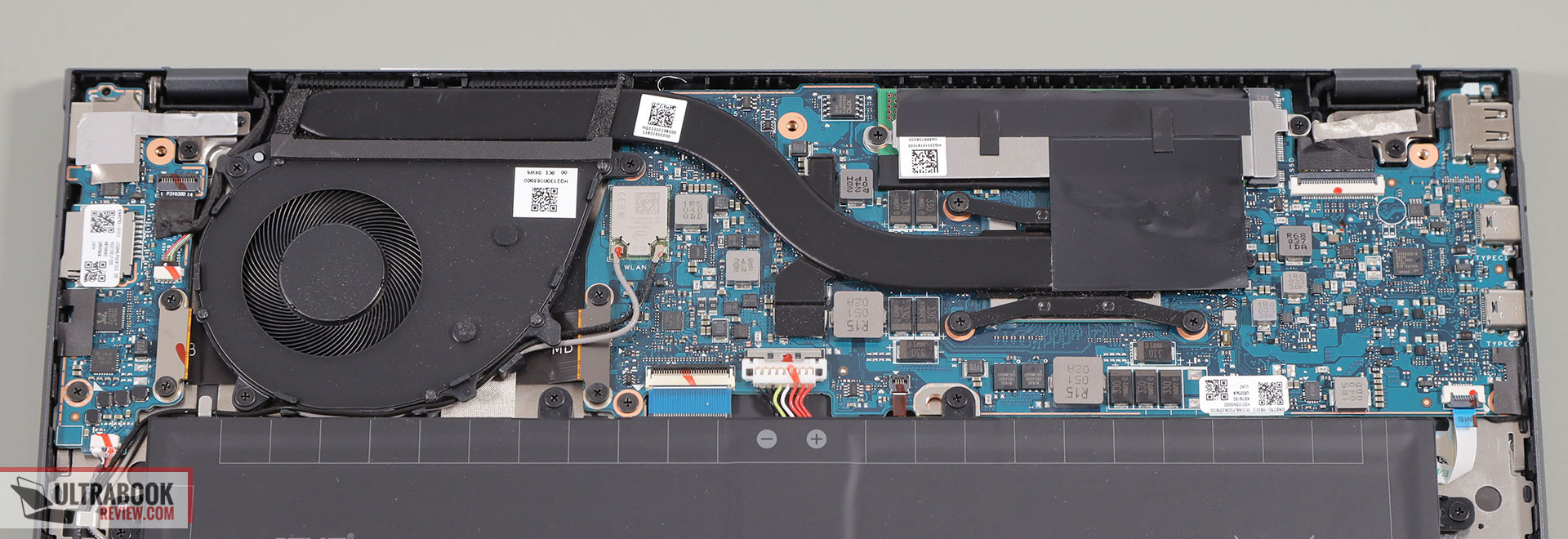
There’s little to complain about the overall thermal performance of this design, even closer to the 25W sustained power settings. Still, fresh air intake is somewhat choked with the laptop sitting on the desk, so you should consider opting for a cooling pad for long work/gaming sessions.
The major benefit of this redesign is the fact that hot air no longer blows into the display, as with all the previous ZenBooks. Instead, hot air is pushed out and away on the left edge.
Chassis temperatures are about average on this laptop, with sub-35 degrees C around the WASD and arrows keys, and around 45 C in the warmest spots around the IO keys, just over the hardware. The same spot on the back hits low-50s Celsius. These measurements are on the Performance mode in Far Cry 5, which keeps the CPU running at 18-25W of sustained power. These temperatures are a little lower in the titles that power down the components.
As for daily use, the chassis temperatures stay within sub-40s C and the fan runs quietly at sub 30 dB with multitasking even on the Performance mode, and it also idles with very light use and video streaming. However, you’ll want to stick to Balanced mode with daily use to prevent any rpm spikes, or even Whisper mode if you’re planning to favor passive cooling with very basic loads.
I’ll also mention that I haven’t noticed any coil whining or other sorts of electronic noises on this ultrabook.
*Daily Use – streaming Netflix in EDGE for 30 minutes, Balanced Mode, fans at 0-30 dB
*Gaming – Performance mode – playing Witcher for 30 minutes, fans at 40 dB
For connectivity, there’s the latest-gen WiFi 6E and Bluetooth 5.2 through a Mediatek MT7922 module on this laptop, which performed excellently during my time with the laptop. This can be upgraded if you want to, as it’s a standard M.2 format, but I see no point in why your would.
Audio is still handled by a set of stereo speakers that fire through grills on the underside, much like on the previous ZenBook lineups. The angled shape of the D-Panel allows the sound to bounce off the table without distortions and prevents you from easily muffling them while using the computer on the lap.
As far as the sound quality goes, it is alright for daily use and streaming, but don’t expect too much. With the Enhanced Audio setting ticked in Windows 11, these speakers get averagely loud at 77-78 dB at head-level, with fair mids and highs, but still little bass, which causes them to sound rather tiny at high volumes.
Finally, there’s an HD camera placed at the top of the screen, flanked by microphones. The image quality is fine for occasional calls, but not much.
Battery life
There’s a 67 Wh battery inside the 2022 ZenBook S 13, larger than the norm for this class.
Here’s what we got in our battery life tests, with the screen’s brightness set at around 120 nits (~60 brightness).
- 7 W (~9-10 h of use) – text editing in Google Drive, Balanced Mode, screen at 60%, Wi-Fi ON;
- 5.5 W (12+ h of use) – 1080p fullscreen video on Youtube in Edge, Whisper Mode, screen at 60%, Wi-Fi ON;
- 4.8 W (12+ h of use) – Netflix fullscreen in Edge, Whisper Mode, screen at 60%, Wi-Fi ON;
- 10 W (~6-7 h of use) – browsing in Edge, Balanced Mode, screen at 60%, Wi-Fi ON;
- 26 W (~2.5 h of use) – Gaming – Witcher 3, Performance Mode, screen at 60%, Wi-Fi ON.
These are excellent runtimes. They’re about 10% better than the previous 5800U ZenBook implementation from 2021, despite the fact that there’s a higher-res OLED screen on this generation. They’re also on par with the ROG Flow X13 2022 with similar Ryzen 6000 hardware, and a significant improvement from any of the Intel options tested so far, especially with video streaming and casual activities.
The laptop ships with a compact 65W USB-C charger. It’s a one-piece design with a strong and long-enough cable, and this design allows you to plug in on either side, based on your need. The battery fully fills up in about 2 hours, with quick charging for the first hour.
Price and availability- Asus ZenBook S 13
At the time of this article, the ZenBook 13 UM5302 is not available in stores yet.
A few sources mention MSRP pricing in the US at $1299 for Ryzen 7 6800U/16 GB/512 GB SSD configuration, and $1449 for 1 TB of storage. That’s competitive for what you’re getting here.
No word on EU/UK prices yet, or the availability of lower-tier Ryzen 5 6600U configurations.
Stay put for updates, and in the meantime, follow this link for updated prices and configurations in your region.
Final thoughts- Asus ZenBook S13 UM5302
The ZenBook S 13 is a more compelling ultrabook than any of its 13-inch ZenBook predecessors before, and one of the best-value ultraportables available as of mid-2022.
That’s partially a consequence of the multiple improvements that Asus brought to this design, addressing the majority of our complaints with the previous generations. This 2022 update is cleaner looking and sturdier built than before, offers uncompromised inputs and a beautiful OLED display, and implements higher-power specs and a superior thermal module design.
At the same time, you do have to accept the USB-C only IO (+ audio jack) without full-size ports and the lack of any non-OLED or matte screen options.
The other part of this bundle is the excellent AMD Ryzen 6000 platform offered with this series, the best-balanced hardware option available for ultraportable design these days. Sure, this compact product with a minimalistic thermal design isn’t fully capable of delivering the full potential of the Ryzen 7 6800U hardware, but even so, the implementation delivers solid performance with daily multitasking, sustained workloads, and even light gaming, and should cater to the needs of most potential buyers.
The Intel 12th-gen Core P options available as alternatives have an edge in CPU IPC performance, which translates into advantages in specific workloads, but the AMD hardware compensates with GPU and combined performance, and seals the deal thanks to its uncontested efficiency on battery.
Nonetheless, higher-power Ryzen 7 6800U models with dual-fan dual-heatpipe thermal modules will outmatch the performance that this S 13 can deliver, by as much as 25% in some cases. However, those won’t be as compact or lightweight, and they might not be even available – from what we know so far, Ryzen 6000 U hardware is in very short supply, and you’ll most likely have a hard time finding 6600U/6800U laptops in stores in the months to come. Time will tell.
Bottom point, if you’re alright with this sort of minimalist port layout and glossy OLED panel, with all its particularities, the ZenBook S 13 UM5302 is definitely a recommendation in the 13-inch ultraportable space. Other options to keep an eye on are the Lenovo Yoga 7 convertible already announced with 6800U hardware, and a potential upgrade of the ultralight HP Pavilion Aero 13, with its matte screen options and sub-1-kilo weight.
That wraps up this review of the ASUS ZenBook S 13 OLED UM5302TA. Let me know what you think about it in the comments section below.
